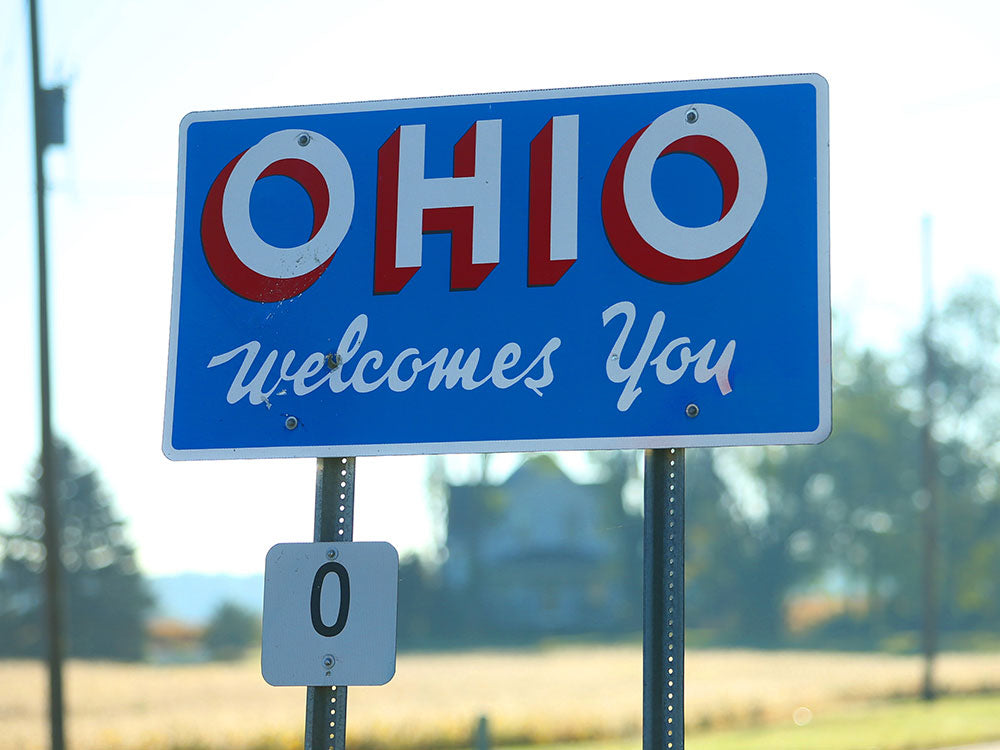Table of Content
1. Introduction
Even though motorcyclists have their sights set on navigating the winding roads and maneuvering at high speeds, they must become familiar with operating the two-wheeled motor vehicle first. Learning how to use the controls and balance on your ride are the practical aspects you need to master when you finally hit the road. But you also have to know the rules of the road and get an idea of the appropriate behavior when cruising down highways. If you are a motorcyclist in Kentucky, there may be restrictions that limit what you can do while riding or liberties that let you have more freedom when operating a motorcycle.
2. Kentucky Motorcycle Insurance

You are not permitted to operate a motorcycle in Kentucky if you do not own Kentucky motorcycle insurance. If you are found riding a motorcycle without liability insurance coverage, you may have your vehicle registration revoked. You can also be subject to fines and/or be jailed for up to 3 months.
Whenever you take your motorcycle out for a ride, you must carry documentation showing that you do indeed have Kentucky motorcycle insurance. You may need to show proof of ownership at stop signs, to police when pulled over, or to any affected parties following an accident.
When you are operating a motorcycle, the insurance you have with you should deal with any injuries suffered and property that were destroyed:
$25,000 for bodily injury to a person per accident
$50,000 for bodily injuries to multiple people per accident
$25,000 for property damages sustained per accident
The mandatory liability insurance coverage needed in Kentucky provides compensation to other drivers for any harm to health or damage to property. However, you can also obtain other types of motorcycle insurance. If you are interested, here are a few examples available in Kentucky:
Collision coverage
Comprehensive coverage
Medical payment coverage
Bodily injury coverage
3. Kentucky Motorcycle Helmet Laws

Both motorcyclists and passengers under age 21 have to wear a motorcycle helmet while in Kentucky. Putting on protective headgear is also a requirement if you have less than a year’s worth of riding experience or are currently holding a Kentucky motorcycle instruction permit.
Statistics in recent years have emphasized the importance of riders wearing the appropriate protective headgear in Kentucky:
Since the repeal of the universal helmet policy in 1998, there has been a 50% increase in motorcycle fatalities in Kentucky
In 2014, there was a total of 1,275 motorcycle injuries and 76 fatalities in Kentucky
In 2014, only 668 of the motorcycle injuries were wearing protective headgear
In 2014, only 46 of the motorcycle fatalities were wearing protective headgear
Your motorcycle helmet, whether it be a three-quarter or full-face helmet, must have been made by the Snell Memorial Foundation and has been approved by the U.S. Department of Transportation. If you are looking for a motorcycle helmet, make sure that they have the following features:
| Requirements | Three-Quarter Helmet | Full-Face Helmet |
|---|---|---|
| Has the Department of Transportation (DOT) sticker | ✔️ | ✔️ |
| Contours around your head to fit snugly due to comfort padding | ✔️ | ✔️ |
| No signs of damage Ex:// cracks, loose padding, scratches, or frayed straps | ✔️ | ✔️ |
| Has a face shield with no scratches | ❌ | ✔️ |
| Includes separate eye protection with no scratches Ex:// goggles, glasses | ✔️ | ❌ |
| Has a hard and durable outer shell that is shatter-resistant | ✔️ | ✔️ |
| Has an impact-absorbing liner inside the helmet | ✔️ | ✔️ |
| Gives you a clear, peripheral view of your surroundings | ✔️ | ✔️ |
| Securely fastened with neck- or chin-strap | ✔️ | ✔️ |
| Allows airflow without fogging up | ✔️ | ✔️ |
| Can allow you to wear sunglasses underneath | ✔️ | ✔️ |
4. Kentucky Motorcycle License Laws
4.1. Kentucky Motorcycle Instruction Permit
The earliest that a novice rider can try to register for a Kentucky motorcycle instruction permit is following your 16th birthday.
You can pay $15 to be issued a standard credential permit, or you can pay $18 for a real I.D. Regardless of which one you choose, the permit allows you to operate for one year before you need a renewal.
To be given the permit, you must complete the following tasks and fulfill all of the listed criteria:
Present valid identification
Provide proof of Kentucky residency
Provide proof of U.S. citizenship
Provide your Social Security Number
Pass the knowledge exam
Pass the vision exam
Pay the required fees
As you are practicing while holding onto a Kentucky motorcycle instruction permit, keep in mind that you have to comply with additional rules on top of the usual road laws in Kentucky:
You can only operate during daylight hours
You cannot carry passengers
You must be wearing a motorcycle helmet
4.2. Kentucky Motorcycle License
Whether you have practiced with an instruction permit or not, you can only apply for a Kentucky motorcycle license following your 18th birthday.
You can pay $21.50 to be issued a standard credential license that is valid for four years, or you can pay a fee of $43 to be issued a standard credential license that is valid for eight years.
Alternatively, you can pay $24 to be issued a real I.D. license that is valid for four years, or you can pay $48 to be issued a real I.D. license that is valid for eight years.
Listed below are the requirements you will need to fulfill to obtain a Kentucky motorcycle license:
| Requirements | Applicants Ages 16 to 17 | Applicants Ages 18 to 20 | Applicants Ages 21 and Above |
|---|---|---|---|
| Have a valid Kentucky driver’s license | ✔️ | ✔️ | ✔️ |
| Complete a Motorcycle Safety Education Program | ✔️ | ❌* | ❌* |
| Held onto a Kentucky motorcycle instruction permit for a calendar month | ❌ | ❌ | ✔️ |
| Held onto a Kentucky motorcycle instruction permit for 180 days | ✔️ | ✔️ | ❌ |
| Provide proof of Kentucky motorcycle insurance | ✔️ | ✔️ | ✔️ |
| Provide proof of Kentucky vehicle registration | ✔️ | ✔️ | ✔️ |
| Fill out the appropriate driver’s license application | ✔️ | ✔️ | ✔️ |
| Must have the consent of a parent or legal guardian if you are a minor | ✔️ | ❌ | ❌ |
| Provide your social security number | ✔️ | ✔️ | ✔️ |
| Pay required fees | ✔️ | ✔️ | ✔️ |
| Present valid photo I.D. | ✔️ | ✔️ | ✔️ |
| Take a photo | ✔️ | ✔️ | ✔️ |
| Take vision exam | ✔️ | ✔️ | ✔️ |
| Pass the knowledge test | ✔️ | ✔️ | ✔️ |
| Pass the skills test | ✔️* | ✔️* | ✔️ |
| Provide proof of U.S. citizenship | ✔️ | ✔️ | ✔️ |
| Provide proof of residency in Kentucky | ✔️ | ✔️ | ✔️ |
*While completing a Motorcycle Safety Education Program is only required for minors between the ages of 16 to 17, applicants of all ages are allowed to attempt this course. If you submit proof of successfully passing this course, you have the option of waiving the skills test.
4.3. Kentucky Motorcycle License Test

Written Portion:
Complete 40 multiple-choice questions
Questions will be based on content from Kentucky Motorcycle Operator Manual
Requires a passing grade of 80% or higher
Riding Portion:
Will be conducted in a controlled, off-street area
Your motorcycle will be subjected to a pre-ride inspection to ensure it meets safety standards
Demonstrate a basic understanding of motorcycle operation
You will be tested on your ability to stay within the speed limit, adjusting speed and position, maintaining visibility, operating under stress, accelerating, braking, turning, stopping, and swerving
The examiner will grade you based on how well you ride at safe speeds, stay within the lanes, and demonstrate riding maneuvers
5. Kentucky Motorcycle Passenger Laws

In Kentucky, passengers who want to ride with you do not have to meet or be older than a minimum age requirement.
So that you do not run into trouble with the law for precariously seating your passenger, you should put up a passenger seat in an obvious position that is easy to spot. Qualities to look for in a passenger seat are comfortable padding and a backrest.
The passenger seat must be placed in one of the following positions on your motorcycle:
At the back of a large driver’s seat
Towards the rear as a separate saddle
Fixed to the side as a sidecar
When determining who is fit to ride with you on your motorcycle, make sure that your passenger follows these requirements:
Your passenger must be able to reach the footrests
Your passenger must wear an approved motorcycle helmet
Your passenger cannot be carrying any packages
Your passenger must be able to understand and follow your directions
6. Kentucky Lane Splitting Laws

In Kentucky, lane splitting is neither stated as being legal nor illegal, therefore leaving it up to the rider to decide whether to attempt lane splitting or not. However, it is recommended you refrain from this practice since you would be riding in the blind spots of other vehicles. The following behaviors are examples of lane splitting and should be avoided:
Riding on top of the dividing lines between lanes
Riding in between adjacent rows of stopped vehicles
Overtaking a larger vehicle ahead in the same lane
As motorcycles require the full space within a lane to take full advantage of their maneuverability, riders should never attempt to lane share. Motorcyclists are always entitled to utilize the entire space within the lane they are currently in.
7. Kentucky Motorcycle Safety Features

If it has been a while since you have conducted a thorough inspection of your motorcycle, you may want to start making it a habit to examine your vehicle before embarking on trips. Checking the primary components and making repairs when necessary will help keep your motorcycle in peak condition. Even if there are no obvious signs of damage, neglecting inspections of your vehicle could result in its functionality gradually becoming worse over time.
Listed below is the integral equipment your motorcycle needs for its visibility and performance when riding through Kentucky:
Horn
Wheels
Tires
Handlebars
Front and Rear Brakes
Controls
Headlight (Low & High Beams)
Taillight
Brake Light
License Plate Light
Exhaust System
Muffler
Rearview Mirror
8. Sources
- Kentucky Motorcycle Manual
- Drive Kentucky - Motorcycles & Mopeds
- Drive Kentucky - Mandatory Insurance
- Drive Kentucky - Motorcyclist Safety
- Drive Kentucky - Pricing
- Kentucky Safety Facts Motorcycle Safety













Leave a comment
All comments are moderated before being published.
This site is protected by hCaptcha and the hCaptcha Privacy Policy and Terms of Service apply.